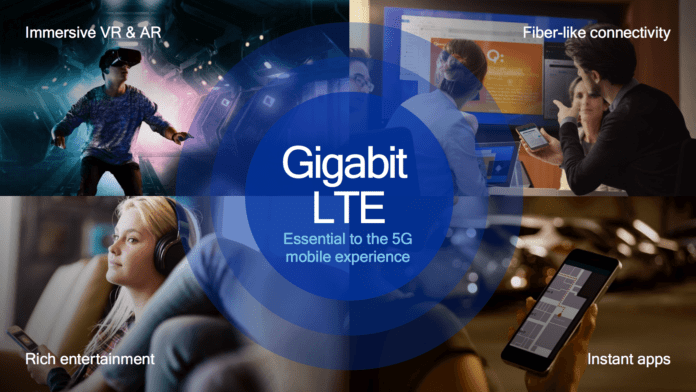Combine carrier aggregation, 4×4 MIMO, 256-QAM, and LAA to provide a gigabit LTE experience for users, while increasing network efficiency
As the standards and testing work around 5G continues, some of the foundational technologies are being deployed by operators today to provide a gigabit LTE experience to users, while simultaneously opening up new use cases and driving network efficiency by improving spectral utilization.
Australian service provider Telstra launched the first commercial gigabit LTE network this year in partnership with Qualcomm Technologies, Netgear and Ericsson. The service is available in portions of the central business districts in Melbourne, Sydney and Brisbane. Users can download a song in less than a second or download a 3GB HD movie in less than three minutes. In the U.S., T-Mobile, AT&T and Sprint, which launched recently at an event in New Orleans are all focusing on Gigabit LTE in 2017; telcos in Asia and Europe are also working to offer gigabit-class LTE.
To learn more about gigabit LTE, RCR Wireless News Editor Martha DeGrasse discussed the topic with Serge Willenegger, SVP of Product Management, Qualcomm Technologies, at the company’s facility in San Diego, California.
He said gigabit LTE is about more than just faster peak rates. “It’s also a proxy for a number of technology capabilities that help enable just better user experience on the device, better coverage for data connectivity and, really, higher throughput in general. That would enable better use cases, better user experience. It’s really about moving the ecosystem, the industry, into a new direction and enabling a new business model and new use cases.”
In terms of new use cases, Willenegger mentioned augmented reality and virtual reality as well as consistent cloud connectivity for enterprise users and industrial internet of things applications like factory automation among others.
Willenegger identified three key technological components of gigabit LTE. First is carrier aggregation, which bundles LTE channels together to create higher bandwidth and higher data rates. Then, the move from 2×2 MIMO to 4×4 MIMO, which could achieve a theoretical throughput of 1.2 Gbps used in tandem with three-channel carrier aggregation. Finally, LAA technology allows for deployment of LTE in unlicensed spectrum, as well as enables aggregation of unlicensed and licensed spectrum.
“What we’ve also done is enabled the operation of LTE technology in unlicensed spectrum,” Willenegger said. “Essentially, that allows operators who don’t have sufficient spectrum assets, or the spectrum assets are occupied by the traffic, to expand into this additional spectrum and offer gigabit LTE. By doing that we’ve expanded the addressable opportunity from 16% of the carriers in the world to about 90%.”
The advancement to 4×4 MIMO speaks directly to increases in spectral efficiency, as Willenegger explained: “It can also be used to improve the economics of the network by being able to send more bits per resource of spectrum or base station antennas–step by step…improve the economics and enable things like unlimited data plans or high definition video on the device. Directionally, the economics keep being improved.”
Click here to learn more about how Qualcomm is enabling gigabit LTE.

